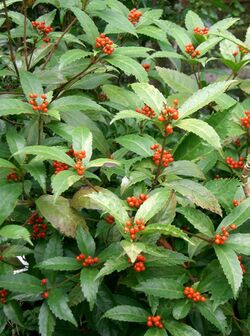Biology:Sarcandra glabra
| Sarcandra glabra | |
|---|---|

| |
| Sarcandra glabra | |
| Scientific classification | |
| Kingdom: | Plantae |
| Clade: | Tracheophytes |
| Clade: | Angiosperms |
| Order: | Chloranthales |
| Family: | Chloranthaceae |
| Genus: | Sarcandra |
| Species: | S. glabra
|
| Binomial name | |
| Sarcandra glabra (Thunb.) Nakai
| |
| Synonyms[1] | |
| |
Sarcandra glabra is a herb native to Southeast Asia. It is also known as herba sarcandrae or glabrous sarcandra herb. Its common names include the nine-knotted flower and the bone-knitted lotus.[citation needed]
Aromatic oils may be extracted from the leaves. This extract has been shown in mice to reduce immunologic attenuation due to stress.[2]
Morphology
This section may be incomprehensible or very hard to understand. (June 2022) (Learn how and when to remove this template message) |
Leaf blade elliptic or ovate-lanceolate, 6–17 × 2–6 cm, leathery, margin sharply coarsely-serrate. Stamen baculate to terete; thecae shorter than connective. Stigma subcapitate. Fruit globose or ovoid, 3–4 mm in diam.[3]
Distribution
The plant is distributed in Vietnam, Sri Lanka, Taiwan, Cambodia, Malaysia, India , Japan , Korea, the Philippines and, in China , Jiangxi, Anhui, Fujian, Guizhou, Guangxi, Hunan, Sichuan, Yunnan, Guangdong, Zhejiang and other places, growing at an altitude of 420 meters to 1,500 meters, often growing on wet slopes and in shaded valleys.
Use in Japanese culture
The plant is called Senryō (千両) in Japanese. It is used during Japanese New Year for chabana decoration, normally along winter jasmine.[4][5] Others plants used instead of Sarcandra glabra because of its similarity to it are coralberry trees and Ardisia japonica.[4]
References
- ↑ The Plant List: A Working List of All Plant Species, http://www.theplantlist.org/tpl1.1/search?q=Sarcandra+glabra, retrieved 7 January 2017
- ↑ He, RR; Yao, XS; Li, HY; Dai, Y; Duan, YH; Li, YF; Kurihara, H (2009). "The anti-stress effects of Sarcandra glabra extract on restraint-evoked immunocompromise". Biol. Pharm. Bull. 32 (2): 247–52. doi:10.1248/bpb.32.247. PMID 19182384.
- ↑ Nianhe Xia; Joël Jérémie (1999), "Sarcandra Gardner, Calcutta J. Nat. Hist. 6: 348. 1845", Flora of China, 4, pp. 132–138, http://www.efloras.org/florataxon.aspx?flora_id=2&taxon_id=129181
- ↑ 4.0 4.1 "万両 千両 十両の見分け方 和風の自然な庭に似合う植物(12月)です - Hanana tree". 17 December 2017. https://murasakihanana.link/archives/1936.
- ↑ "千両/万両 せんりょう/まんりょう|暦生活". https://www.543life.com/shun/post20201228.html.
Wikidata ☰ Q2746875 entry
 |

